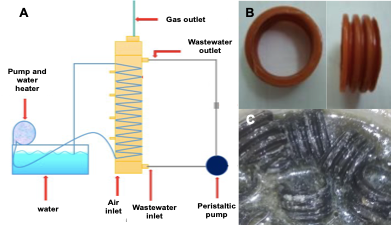 |
|
Waste motor oil generates contamination in water due to its inappropriate disposal and is hence considered a hazardous residue. In this study a native microbial consortium was isolated from soil contaminated with waste motor oil. The ability to grow, biosurfactant production, and degradation of different oil concentrations (0.2, 0.5, 1.0, and 2.5 % v v-1) was analyzed. The growth kinetic analysis revealed the value of the maximum specific growth rate was 0.758 d-1, while the saturation constant was 0.781 % v v-1 (7.11 mg mL-1) and the inhibition constant, 2.60 % v v-1 (23.77 mg mL-1). Waste motor oil (1.0% v v-1) was used in the biodegradation oil studies using a packed-bed bioreactor and native microbial consortium immobilized over plastic rings. The results obtained showed the biosurfactant production capacity was 398.18 mg L-1 and the efficiency of waste motor oil was 67.76%. The results obtained in the present work represent a significant advantage in bioremediation of oil contaminated water.
Keywords: waste oil, biodegradation, hydrocarbons, bacteria, water.
|
|
 |

